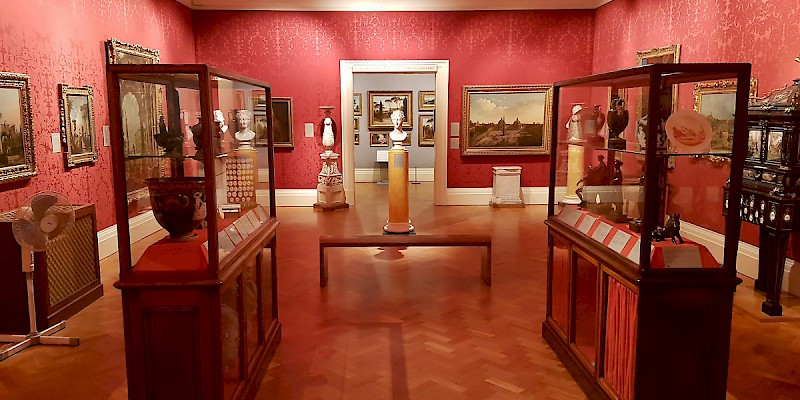Ashmolean Museum ★★☆

A fantastic bit-of-everything museum including Old Masters paintings
If you only visit one museum in Oxford, make it the Ashmolean Museum, one of Britain's best (and oldest), founded in 1683—making it among the oldest museums in the world.
Beyond the historic musical instruments (including the world's most valuable Stradivarius violin), antiquities—Greek, Egyptian, Minoan, Roman, Anglo-Saxon—and international curios, the painting collection is most impressive, featuring works by Paolo Uccello, Giovanni Bellini, and Édouard Manet, along with works by the Pre-Raphaelites (19C artists who reveled in medieval themes and styles) and sketches by Renaissance Titans Raphael and Michelangelo.
Among the Ashmolean Museum's highlights:
Antiquities and other objects
- The Alfred Jewel, discovered in 1693, a 9C masterwork of Anglo-Saxon craft made of enamel and quartz enclosed in gold, created probably as the handle to a pointer rod for reading during the reign of Alfred the Great, and inscribed with the words "AELFRED MEC HEHT GEWYRCAN" (Alfred ordered me made').
- Cycladic sculptures and figures from the third millennium BC.
- The Messiah-Salabue Stradivarius is one of the most valuable violins in the world and the only Stradivarius still in an "as new" condition, as it was rarely played. This musical masterpiece was made by Antonio Stradivari in 1716, but remained in his Cremona workshop until his death in 1737.
- The Bodleian Bowl, a medieval English Jewish artifact made of copper and found in a Norfolk moat in 1696, connected to the 13C French rabbi and Talmudic scholar Yechiel of Paris.
- The Chest of Courtrai, a.k.a. the Chest of Oxford, an medieval oaken chest carved with scenes celebrating the Flemish victories of the Franco-Flemish War, including the 1302 Matins of Bruges (in which a Flemish militia in Bruges massacred the occupying French garrison at night) and the subsequent Battle of the Golden Spurs, or Battle of Kortrijk (which, in French, was spelled "Courtrai"), in which Flrmeish footsoliders defeated the mounted knights of the French calvary. The details in the carving suggest the scultpor himself was likely present during the battles.
- Mummy portraits, encaustic (tinted wax) paintings on wood panels common on late Egyptian mummies from the 1st to 3rd centuries AD.
Paintings
- La Caccia Notturna (The Hunt in the Forest) (c.1465–70) by early Renaissance master of perspective Paolo Uccello. Also here is his Annunciation (c. 1425).
- Watercolors on the life of Dante (1850s) by the Oxford-based co-founder of Pre-Raphaelite movement, Dante Gabriel Rossetti.
- A Converted British Family sheltering a Christian Missionary from the Persecution of the Druids (1850) by William Holman Hunt, one of the founders (along with Oxfordian Dante Gabriel Rossetti) of the Pre-Raphaelite Brotherhood in 1848.
- Giovane donna con pappagallo (Young Woman with a Parrot) (1758–60) by Italian late baroque master Giambattista Tiepolo.
- Early Impressionst works, like Landscape at Pontoise (1872) by Camille Pissarro and Landscape with a Village Church (1870s) by Édouard Manet.
- Incendio nella Foresta (Fire in the Forest) (c. 1505) by Piero di Cosimo, an unusual Renaissance painting depicting a passage from Book 5 of De Rerum Natura by the 1st century BC Roman author Lucretius.
- Meeting of Joachim and Anne at the Golden Gate (1445) by Fra' Filippo Lippi, the Renaissance monk who taught Botticelli how to paint.
- Portrait of Giacomo Doria (1533–35) by Renaissance master Tiziano (Titian).





























